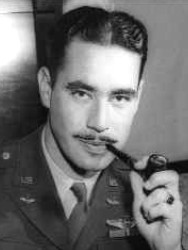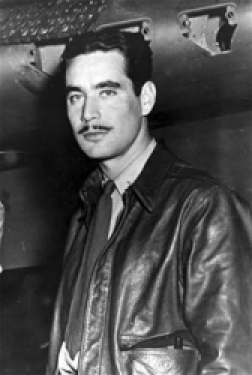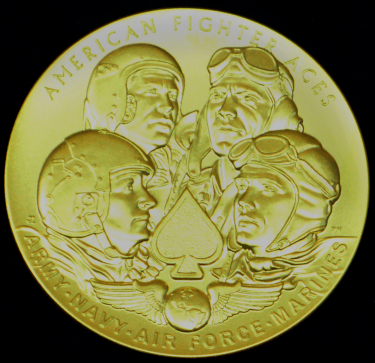
 |
|
|
||
|
Boyd David Wagner 'Buzz' |
||||
|
Engagements: • World War II (1941 - 1945) |
||||
| Biography: | ||||
|
Boyd David "Buzz" Wagner Boyd David Wagner was born on 26 October 1916 in Emeigh, PA, the son of Boyd M. Wagner and Elizabeth M. Moody Wagner. He grew up in Nanty-Glo, near Johnstown, and studied Aeronautical Engineering at the University of Pittsburgh for three years before joining the U.S. Army Air Corps. Wagner completed flight training in June 1938 and was assigned to duty in the Philippines with the 24th Pursuit Group. He was soon given command of the 17th Pursuit Squadron. He was nicknamed "Buzz" because it was said he could buzz the camouflage off a hangar roof. Wagner was a First Lieutenant commanding the 17th Pursuit Squadron stationed at Nichols Field on 8 December 1941 when the first Japanese air attacks struck the Philippines. On 12 December, 1LT Wagner took off in a P-40 Warhawk Fighter Plane on a solo reconnaissance mission over Aparri, where he was attacked by Japanese Zero fighter planes. He dove away from the attacking planes, then returned and shot down 2 of them. 1LT Wagner was attacked by more Zeros as he strafed a nearby Japanese airfield and subsequently destroyed 2 of those planes as well before returning to Clark Field. On 16 December 1941, 1LT Wagner was leading a reconnaissance mission over a Japanese airstrip near Vigan, Philippine Islands, with Lieutenants Allison W. Strauss and 1LT Russell M. Church, Jr. 1LT Wagner left one airplane of his formation above a Japanese airfield to continue observation and, with a companion, drove through heavy enemy anti-aircraft fire to obtain vital information. Observing about 25 Japanese airplanes on the landing strip, 1LT Wagner dove directly on them releasing 6 fragmentation bombs and making several direct hits. A sole Japanese Zero took off and attacked 1LT Wagner's plane but he chopped his throttle and caused the Zero to overshoot his plane. Once in position behind the Zero, Wagner was able to shoot it down. Although left unsupported due to the destruction of 1LT Church's plane, 1LT Wagner continued his attack sweeping the hostile airplanes on the ground 5 times with machine gun fire and setting fire to the enemy's fuel supply before returning to report the accomplishment of his mission. 1LT Wagner’s flying skills, courageous actions and extraordinary heroism that day earned him the U.S. Army's second highest award for valor, the Distinguished Service Cross. 1LT Wagner got his 5th aerial kill that day, making him the 1st USAAF Ace of World War II. At least one source states that Wagner's first five kills were not Zeros, but were IJAAF Nakajima Ki-27 "Nate" fighter planes. This source does confirm his later kills were reported as Zeros but were impossible to verify from Japanese records. Attacking the Japanese again at Vigan on 22 December, his plane was struck by enemy fire and he was wounded by glass splinters which struck his face and eyes. He returned to base safely and was evacuated to Australia in January 1942. In April 1942, Wagner was promoted to Lieutenant Colonel and assigned to the 8th Fighter Group in New Guinea flying the Bell P-39 Airacobra. At the time, he was the youngest Lieutenant Colonel in the U.S. Army. On 30 April 1942 he shot down 3 Zeros, bringing his air-to-air kill total to 8 planes. Higher up in the chain of command, it was decided that LTC Wagner's experience and knowledge would be more valuable back in the U.S., training fighter pilots and as a liaison to the Curtiss P-40 plant in Buffalo, NY, to help engineers improve the Warhawk's combat performance. Despite LTC Wagner's protests at being removed from combat, he was returned to the U.S. Fatal Crash On a routine flight in a P-40K Warhawk from Eglin Field, FL, to Maxwell Field, AL, on 29 November 1942, LTC Wagner's plane disappeared. After an extensive search, the P-40 wreckage and LTC Wagner's partial remains were found almost six weeks later in January 1943, 25 miles east of Eglin. The cause of the crash, if known, was never revealed. After the crash site was found, the partial remains of LTC Wagner were found and returned for burial. An estimated 15,000 to 20,000 mourners attended his funeral at Grandview Cemetery in January 1943. Both Time Magazine and Life Magazine covered the event. After five years of research, retired Air Force Colonel Jim Moschgat rediscovered what he believed to be the crash site of Wagner's plane in Florida and found artifacts that tentatively confirmed the crash site was the correct one. Human remains were found at the site in 2008. In 2010 the remains were confirmed as being LTC Wagner's. His remains were buried with full military honors, to include a fly over by the U.S. Air Force at the Grandview Cemetery at Southmont, Cambria County, PA. Medals, Awards and Badges Distinguished Service Cross Distinguished Service Cross Citation The President of the United States of America, authorized by Act of Congress July 9, 1918, takes pleasure in presenting the Distinguished Service Cross to First Lieutenant (Air Corps) Boyd David Wagner (AFSN: 0-21623), United States Army Air Forces, for extraordinary heroism in connection with military operations against an armed enemy while serving as Pilot of a P-40 Fighter Airplane in the 17th Pursuit Squadron, 24th Pursuit Group, FAR EAST Air Force, in aerial combat against enemy forces on 16 December 1941, during an air mission over Vigan, Philippine Islands. While leading a reconnaissance mission Lieutenant Wagner left one airplane of his formation above a hostile airfield to continue observation and with a companion drove through heavy enemy anti-aircraft fire to obtain vital information. Observing about twenty-five hostile airplanes on the landing strip he dove directly on them releasing six fragmentation bombs and making several direct hits. In spite of being left unsupported due to the destruction of the accompanying airplane, he continued his attack sweeping the hostile airplanes on the ground five times with machine gun fire and setting fire to the enemy's fuel supply before returning to report the accomplishment of his mission. First Lieutenant Wagner's unquestionable valor in aerial combat is in keeping with the highest traditions of the military service and reflects great credit upon himself, the Far East Air Force, and the United States Army Air Forces. Headquarters, U.S. Army Forces in the Far East, General Orders No. 52 (1941) Honors Two schools at Clark Air Base were named in honor of Boyd Wagner: Wagner High School and Wagner Middle School. Congressional Gold Medal The Congressional Gold Medal, created by the U.S. Mint, is the highest civilian honor Congress can give on behalf of the American people. On 20 May 2015, leaders from the U.S. House of Representatives and Senate presented the Congressional Gold Medal [see photo] to the American Fighter Aces Association at the U.S. Capitol Visitor Center Emancipation Hall. More than 60,000 American fighter pilots engaged in aerial combat during World War I, World War II, the Korean War and the Vietnam War. Of those pilots, only 1,447 earned the title of fighter “Ace” by downing at least five enemy aircraft. Lieutenant Colonel Boyd David Wagner was one of them, having been credited with 8 aircraft shot down in aerial combat. At the time of the presentation of the Medal, only 75 of those Aces remained alive. Death and Burial Lieutenant Colonel Boyd David Wagner died in a plane crash on 29 November 1942 in Walton County, FL. Ultimately, all of his recovered remains were interred at the Grandview Cemetery at Southmont, Cambria County, PA. |
||||
| Origin of Nickname/Handle: | ||||
|
He was nicknamed "Buzz" because it was said he could buzz the camouflage off a hangar roof. |
||||
| Honoree ID: 3178 | Created by: MHOH | |||
Ribbons
Medals
Badges
Honoree Photos
 |  |  |
 |  |
 |


